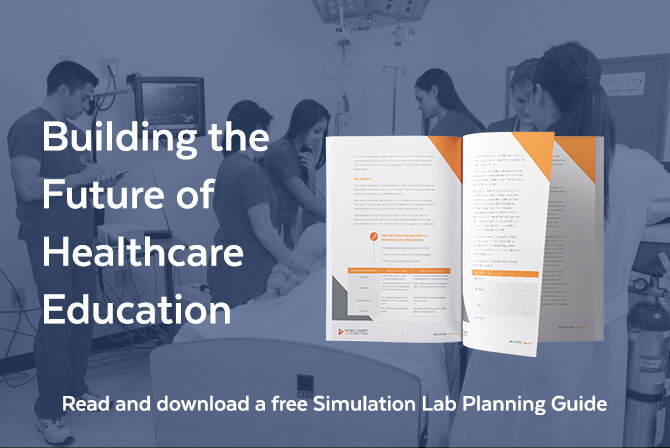Healthcare Simulation Learning: 5 Benefits of Video Capture Systems
Simulation learning is an essential element of training for healthcare providers that offers an immersive, reviewable, and repeatable learning experience to strengthen students’ learning and help healthcare providers save money and reduce mistakes.
Video capture systems enhance simulation learning by allowing medical teams to create recordings of teaching sessions that provide a real-time visual reference with a variety of teaching and learning applications.
In this blog, we’ll explore the five benefits of incorporating video capture systems into your healthcare simulation learning programs.

Considering a new Simulation Space?
1. Reduces the Live Observation Burden on Supervisors
Video capture gives supervisors the flexibility to observe and evaluate a student’s performance even if they cannot be in the room while it’s happening. Supervisors can enjoy the freedom to choose between live or recorded sessions, while still facilitating positive learning and feedback. Evaluators can also review recorded simulation sessions multiple times, which can reveal details that would have gone unseen during a single in-person (or video) observation.
Video capture also facilitates sharing: cross-faculty evaluation that provides insights from diverse perspectives, peer review, and debriefing sessions, all of which create opportunities to generate comprehensive feedback and maximize the educational experience.
In this blog, we’ll explore five benefits of incorporating video capture systems into your healthcare simulation learning programs.
2. Captures Skills Progression and Areas for Improvement
While healthcare learning simulation videos provide a visual record of a student’s performance, archived videos can provide a dynamic record of a student’s progression.
Early program videos illustrate a knowledge baseline, and help instructors develop learning objectives and skills development goals. Subsequent videos reveal recurring mistakes and illustrate increased proficiencies, which helps students understand supervisors’ critiques and celebrate their achievements and growth.
Peer review is another powerful impact of skills progression analysis as students can share their experiences and discuss best practices based on simulation experiences.
3. Provides a More Accurate Alternative to Self-reported Evaluation
Self-reported evaluation is, by nature, subjective: “This is how I think I performed based on my recollection of the event.”
Video capture creates an objective view of the learning experience, which does not rely on the student’s recollection and is not affected by the student’s cognitive biases or personal confidence (or lack thereof) in their performance. A video recording also captures the subtle details of the learning session that might go unnoticed or be forgotten by the student as time passes.
Compared to traditional self-reported evaluations, video capture delivers an objective record of a student’s performance from which the instructor can provide more effective feedback and appropriate learning goals.
4. Allows for Immediate Reflection and Debriefing
Video capture can increase the effectiveness of simulation learning by allowing learners to review the simulation immediately after it has occurred.
Video capture creates a comprehensive and objective record of the simulation that students and faculty can review while the experience is still fresh in their minds. This powerful “instant reply” allows students and teachers to reflect on the decisions, actions, and outcomes of the simulation to recognize achievement and progress while identifying areas for improvement.
Used as a peer review tool, video capture enhances debriefing by facilitating discussion as participants can share their perspectives and work toward developing best practices.
5. Enables Video Modeling and Video Self-modeling Teaching Strategies
Video modeling—watching instructors or clinical experts demonstrating procedures or working through scenarios—provides a visual benchmark that helps students understand the theories and practical aspects of a topic.
Modeling videos offer many benefits, including:
- Shared learning opportunities such as reviewing peers’ sessions and discussing faculty demonstrations.
- Consistency in training.
- Facilitating self-reflection by giving learners an opportunity to view their own actions and behaviors, helping them identify areas for improvement, and building their confidence.
- Reviewing accumulated videos over time provides an ongoing comparison of performance and indication of progress that illustrates achievement and identifies areas for improvement.
Video capture also provides an opportunity to integrate modeling and self-modeling by creating an opportunity for learners to observe faculty or peers perform a task before participating in a simulation and then review a recording of their performance. This “watch, do, review” approach provides a comprehensive learning experience that teaches, corrects, and reinforces new skills.
Curious about getting started with A/V capture? Read this blog about obtaining a grant.
Incorporating video capture systems into healthcare simulation learning improves the medical teaching and learning experience for students and faculty alike.
From reinforcing basic skills to practicing surgical procedures, medical and nursing colleges throughout the country are utilizing video capture systems to help students improve their technical abilities, critical thinking, decision-making, and teamwork.
Whether you’re creating a new simulation learning environment or improving your simulation learning program, Intelligent Video Solutions’ Healthcare Simulation Lab Planning Guide is the perfect resource for your team. Our comprehensive guide helps you brainstorm ideas, develop your plan, identify key players and funding, and evaluate equipment. Click here to download the planning guide!
Interested in learning more about simulation? Here are some additional helpful resources!
- Overview: Video Recording Systems for Simulation Labs
- Blog: Essential Tech Support for a Simulated Environment
- Resource: How to Do More With A/V Capture
- Resource: Simulation Lab Planning Template
- Checklist: 19 Questions To Ask Clinical Simulation Center Video Capture Vendor
Watch this helpful video to see how simulation works in a healthcare environment.
If you’re considering simulation to save your organization from costly mistakes, check out this guide to a key component of simulation-based training:









